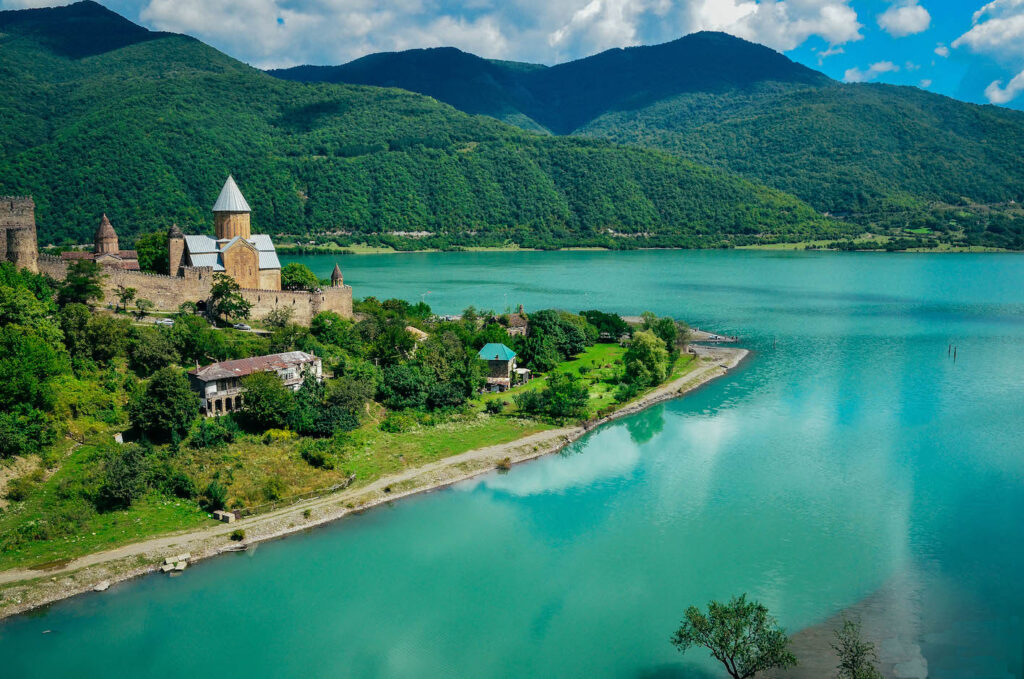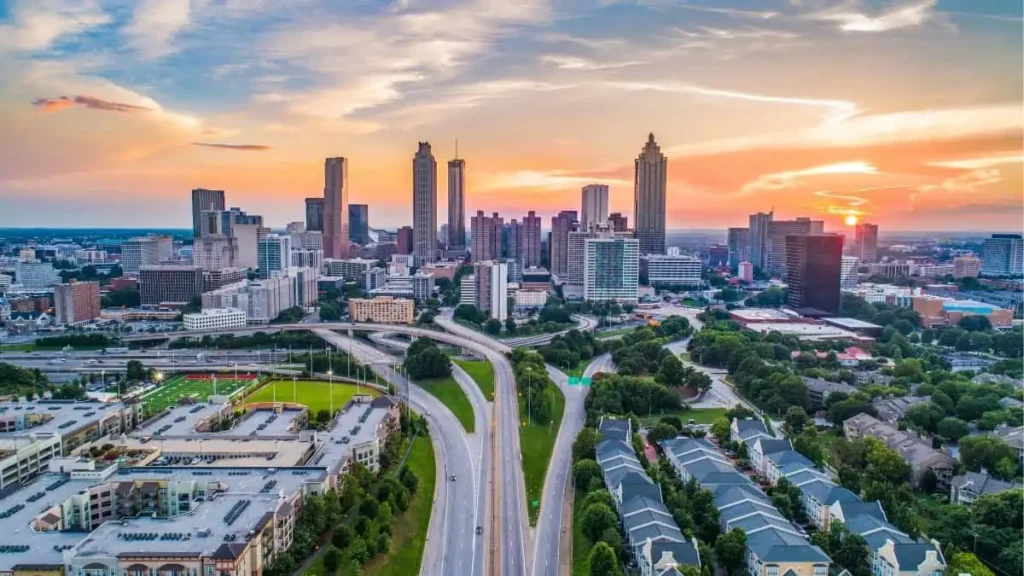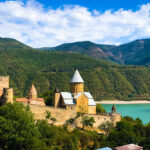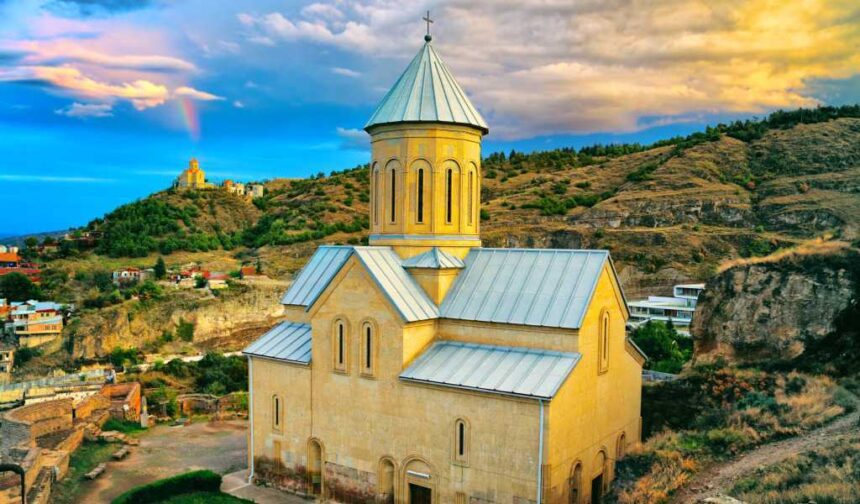Georgia – known as the “Peach State” – is a destination that truly has it all. From remote marshlands and roaring rivers to pristine beaches and picturesque mountains, this southern U.S. state overflows with charm. Georgia invites you to wander historic squares under moss-draped oaks, hike to panoramic waterfalls, and relax on golden sand islands. It’s a place where vibrant modern cities meet quaint small towns, where civil rights history and rich culture greet you at every turn.
No wonder tourism is booming – Georgia welcomed a record 171 million visitors in 2023. Whether you’re an Indian traveler planning an American adventure or a U.S. local exploring your own backyard, our Georgia travel guide for 2025 will help you discover the best places to visit in Georgia, must-do experiences (including the top things to do in Atlanta), offbeat hidden places in Georgia, and practical travel tips.
Get ready to experience famous Southern hospitality and create unforgettable memories – let’s dive into Georgia’s wonders!
Best Places to Visit in Georgia

Georgia offers a mix of bustling cities, historic towns, and breathtaking natural landscapes. Here are some of the best places to visit in Georgia for a well-rounded trip:
- Atlanta: The dynamic capital city is a gateway to the South and a must-visit. Atlanta seamlessly blends modern attractions with history. Don’t miss the Georgia Aquarium (one of the world’s largest, home to whale sharks and beluga whales), the World of Coca-Cola museum, and the Centennial Olympic Park area. History buffs can tour the Martin Luther King Jr. National Historic Park to see Dr. King’s childhood home and church. Atlanta’s diverse neighborhoods (Midtown, Little Five Points, Buckhead) offer renowned restaurants, nightlife, and shopping. From towering skyscrapers to tree-lined parks, Atlanta delivers an energetic urban experience.
- Savannah: Often hailed as one of the most beautiful cities in Americaamericanaffair.com, Savannah enchants visitors with its cobblestone streets and moss-draped oak trees. This coastal city is famous for its 22 historic squares, each with manicured gardens, monuments, and centuries-old oak canopies. Stroll through Forsyth Park and admire its iconic fountain, wander the Savannah Historic District with elegant antebellum homes, and explore the bustling River Street along the Savannah River. Savannah exudes Southern charm and hospitality (it’s nicknamed the “Hostess City of the South”) and was recently ranked among the Top 3 cities to visit in the U.S.. You’ll fall in love with its romantic vibe, ghost legends, and delicious Lowcountry cuisine (don’t leave without trying some shrimp and grits or a praline candy!).
- Golden Isles (Coastal Georgia): Georgia’s coast is dotted with idyllic barrier islands known as the Golden Isles – and they’re world-famous. In fact, Georgia’s Golden Isles (St. Simons Island, Jekyll Island, Sea Island, Little St. Simons, plus the historic port town of Brunswick) were voted the #1 islands in the Continental U.S. two years in a row, even earning a spot among the world’s best island destinations. Visit St. Simons Island for its lighthouse and mossy oak avenues, or Jekyll Island for unspoiled beaches and the historic Jekyll Island Club resort. Jekyll’s eerie Driftwood Beach, strewn with weathered tree trunks, is a photographer’s dream at sunrise. Nature lovers can stop by the Georgia Sea Turtle Center on Jekyll to learn about sea turtle conservation. For a throwback beach town vibe, head to Tybee Island (near Savannah) to climb the 18th-century lighthouse and enjoy fresh seafood by the pier. And if you’re looking for true seclusion, Cumberland Island (Georgia’s southernmost isle) offers wild horses roaming empty sands and ruins of Carnegie mansions – reachable only by ferry. Whether you sunbathe, bike under live oaks, or kayak marsh creeks, Georgia’s coast is not to be missed.
- Blue Ridge & North Georgia Mountains: In the north of the state, the Blue Ridge Mountains (part of the Appalachians) provide a refreshing alpine retreat. You’ll find quaint mountain towns like Blue Ridge, Dahlonega, and Blairsville, set amid rolling hills and vineyards. Outdoor enthusiasts can hike to waterfalls at Amicalola Falls State Park (home to the tallest cascade in Georgia at 729 feet) or trek a portion of the famous Appalachian Trail – which begins in Georgia’s Springer Mountain. The lush Chattahoochee National Forest offers countless trails and scenic drives. In fall, the mountains burst into brilliant autumn colors – a perfect time for a drive to panoramic overlooks or a ride on the Blue Ridge Scenic Railway. Don’t miss Brasstown Bald, the highest peak in Georgia, where on clear days you can see four states from the observation deck. For a unique cultural twist, visit Helen, a small mountain town that recreated itself as a Bavarian alpine village – complete with Oktoberfest celebrations, gingerbread-style architecture, and cozy strudel shops! From apple picking in Ellijay to trout fishing in mountain streams, North Georgia is an outdoor playground brimming with postcard-worthy vistas.
- Historic Heartland (Macon & beyond): To delve into Georgia’s history and culture, consider a trip to the state’s heartland. The city of Macon sits in central Georgia and is famed for its soulful music legacy (it’s the hometown of Little Richard and Otis Redding) and beautiful antebellum architecture. Walk down College Street to see grand Southern mansions, or time your visit for spring’s International Cherry Blossom Festival when over 350,000 cherry trees are in bloom. Macon also safeguards Native American history – the Ocmulgee Mounds National Historical Park features massive ancient earth mounds over 1,000 years old. Nearby small towns like Madison and Milledgeville boast historic districts with Greek Revival homes and charming town squares, offering a glimpse into the Old South. History buffs can follow the Antebellum Trail (a route connecting Georgia’s historic towns spared during the Civil War). This region’s slower pace, nostalgic architecture, and friendly locals make it a rewarding stop between the bustle of Atlanta and Savannah.
Things to Do in Atlanta

As Georgia’s capital and a major travel hub, Atlanta deserves a special spotlight. This sprawling city has something for everyone – history, entertainment, sports, dining, and family fun. Here are some of the top things to do in Atlanta:
- Discover Downtown’s Attractions: Head to downtown Atlanta’s Centennial Olympic Park district, which is surrounded by world-class attractions. You can easily spend a day park-hopping here – marvel at marine life in the Georgia Aquarium (don’t miss the massive whale sharks gliding overhead in the tunnel), explore the interactive exhibits at the World of Coca-Cola (with a chance to taste Coke flavors from around the globe), and delve into inspiring history at the National Center for Civil and Human Rights. Travel Tip: The Civil and Human Rights center is undergoing an expansion and scheduled to reopen with new exhibits by late 2025. Also nearby is the College Football Hall of Fame, a hit with sports fans. For a panoramic view of the skyline, take a spin on SkyView Atlanta, a 20-story-tall Ferris wheel adjacent to the park.
- Explore Civil Rights History: Atlanta played a pivotal role in the American Civil Rights Movement. Visit the Martin Luther King Jr. National Historical Park in the Sweet Auburn district to see Dr. King’s birth home, the Ebenezer Baptist Church where he preached, and the King Center where he and Coretta Scott King are laid to rest. It’s a powerful, reflective experience walking in the footsteps of Dr. King. Nearby, the Center for Civil and Human Rights (mentioned above) provides context with moving exhibits that connect past struggles to present global human rights issues. These sites are a must to understand Atlanta’s history and impact.
- Enjoy Green Spaces & Local Neighborhoods: Despite its skyscrapers, Atlanta is a very green city. Take a stroll or bike ride on the Atlanta BeltLine, an urban trail that loops through various neighborhoods and art installations. Stop at Piedmont Park, the city’s most beloved park, especially if you’re visiting during the spring Atlanta Dogwood Festival or a weekend farmers’ market. The Atlanta Botanical Garden, adjacent to Piedmont Park, is an oasis of blooming flowers and whimsical plant sculptures (like the famous Earth Goddess topiary) – a great spot for families and garden enthusiasts. In the trendy Midtown and Westside areas, you can find vibrant street art, galleries, and the High Museum of Art for a dose of culture. Each Atlanta neighborhood – from artsy Little Five Points to upscale Buckhead – offers its own vibe, so explore whichever suits your interests.
- Feast in the Food Scene: Come hungry, because Atlanta’s food scene is fantastic and diverse. You can savor traditional Southern comfort food (try fried chicken and waffles at local diners or barbecue ribs at spots like Fox Bros. Bar-B-Q), but also cuisines from around the world thanks to the city’s diversity. In fact, Atlanta now even boasts Michelin-starred restaurants and trendy vegan eateries alongside its classic Southern joints. For a quintessential Atlanta experience, swing by The Varsity, an iconic drive-in since 1928, and order a chili dog and frosted orange shake – it’s a local tradition to ask, “What’ll ya have?” If you’re a nightlife lover, check out the bars and live music venues in Midtown or East Atlanta Village. And for a unique food hall experience, visit Ponce City Market, set in a converted historic Sears building, where you can sample everything from gourmet burgers to Indian street food under one roof.
- Sports and Entertainment: Atlanta is a sports lover’s haven. Catch a baseball game at Truist Park (home of the Atlanta Braves) or an NFL game with the Atlanta Falcons at the state-of-the-art Mercedes-Benz Stadium – even if you’re not a huge sports fan, the energy of a game day is infectious. If music and pop culture are more your scene, check the concert calendar for big acts at State Farm Arena or smaller indie shows at venues like the Tabernacle. Atlanta’s also a booming film production center (nicknamed “Hollywood of the South”), so you can tour nearby film sites – for example, visit suburban Covington which doubles as many Hollywood movie towns, or take a guided “Walking Dead” tour in sites outside the city where the hit show was filmed. In short, Atlanta offers endless activities – be sure to tailor your “to-do” list to your interests, and you’ll see why this city is often called “the capital of the New South.”
Hidden Places in Georgia
Beyond the famous tourist spots, Georgia harbors plenty of hidden gems – unique places off the beaten path that offer something special. Here are a few hidden places in Georgia worth seeking out:
- Providence Canyon State Park: Tucked away in southwest Georgia near the town of Lumpkin, Providence Canyon is nicknamed “Georgia’s Little Grand Canyon.” This otherworldly landscape features striking layers of pink, red, orange and purple rock forming steep gullies up to 150 feet deep. Surprisingly, the canyon was created by poor 19th-century farming practices, but today it’s one of Georgia’s most beautiful natural wonders. Hike the rim trails for stunning overlooks or venture down into the canyon floor (prepare for a bit of mud and a truly epic view looking up at the colorful cliffs). In summer, look for the rare Plumleaf Azalea blooming along the trails – it grows only in this region. With minimal crowds and jaw-dropping scenery, Providence Canyon is a photographer’s paradise and a hidden gem that will make you say “I can’t believe this is in Georgia!”
- Cumberland Island National Seashore: If you crave untouched beaches and wild nature, Cumberland Island is a dream come true. Accessible only by ferry from St. Marys, this remote barrier island feels like a step back in time. There are no bridges, cars, or shops – just maritime forests, dune-bordered beaches, and historic ruins. Keep an eye out for the wild horses that freely roam the island’s beaches and meadows; seeing these untamed horses against an Atlantic Ocean backdrop is a magical sight. You can hike or bike to the eerie Dungeness Ruins (the remnants of a mansion owned by the Carnegie family) and spot wildlife from armadillos to sea turtles. Pack a picnic and enjoy the serenity of miles of empty shoreline. Camping is available for the adventurous who wish to sleep under the stars. With limited daily visitors allowed, Cumberland Island offers an exclusive, tranquil experience that’s truly off the beaten path.
- Helen: Imagine a tiny Bavarian alpine village – but in Georgia! The town of Helen, nestled in the North Georgia Mountains, is a quirky German-themed town complete with half-timbered architecture, cobblestone alleys, and even an annual Oktoberfest. It’s a surprise find in the American South and definitely a hidden gem for those who love kitschy charm. You can sample schnitzel and strudel at German restaurants, browse Old World souvenir shops, and take a horse-drawn carriage ride through the fairy-tale streets. Beyond the Bavarian facade, Helen is also a gateway to gorgeous nature: Unicoi State Park is next door, offering hiking trails and the twin waterfalls of Anna Ruby Falls nearby. The Chattahoochee River runs through town – in summer you’ll see visitors tubing lazily downstream right past the alpine village. Helen’s blend of scenic beauty and unexpected European flair makes it a delightful detour.
- Okefenokee Swamp: Spanning nearly 700 square miles in southeastern Georgia, the Okefenokee is one of the largest intact freshwater swamps in North America – and a truly wild hidden paradise. This vast refuge is a maze of cypress swamps, mirror-like blackwater channels, and floating peat bog islands. It’s also famously home to thousands of American alligators (don’t worry, guided boat tours keep a safe distance while letting you observe these prehistoric creatures). Exploring Okefenokee feels like entering another world – the silence broken only by bird calls and the splash of paddles. You can take a daytime boat or kayak tour to spot herons, sandhill cranes, maybe even a black bear, or opt for a nighttime guided paddle under the stars for a hauntingly beautiful experience. Wooden boardwalks lead to observation towers where you can gaze over the wetland expanse. For nature lovers and photographers, Okefenokee Swamp is a hidden gem showcasing Georgia’s wilder side (just bring bug spray and an adventurous spirit!).
Travel Tips for Georgia in 2025
To make the most of your Georgia trip, keep these travel tips in mind:
- Best Time to Visit: Georgia is enjoyable year-round, but spring (March–May) and autumn (Sept–Nov) are generally the most pleasant seasons. In spring, you’ll enjoy mild weather (around 60–80°F / 15–27°C) with blooming dogwoods and azaleas painting the landscapes. Fall brings crisp air, lower humidity, and gorgeous autumn foliage in the mountains (plus fun activities like apple picking and fall festivals). Summers (June–August) can be hot and humid (often 90°F+/32°C, with afternoon thunderstorms), but that’s perfect for beach days on the coast or cooling off in mountain lakes. If you visit in summer, do as locals do and enjoy fresh Georgia peaches and sweet watermelons in season. Winters are generally mild in most of Georgia (daytime 40–50°F / 5–10°C), with rare snow except in the northern mountains. Winter is a quieter time great for city sightseeing and indoor attractions without crowds. Ultimately, plan around your interests – for instance, spring for wildflowers and festivals, fall for hiking and sports (college football season is huge in the South!), etc.
- Getting There & Around: Atlanta’s Hartsfield-Jackson International Airport (ATL) is one of the world’s busiest airports and the main gateway to Georgia, with many direct flights (including from India via connecting hubs). From Atlanta, you can reach most destinations in Georgia by car. Renting a car is highly recommended if you plan to explore beyond the cities – much of Georgia’s charm lies in small towns and natural areas where public transport doesn’t reach. Driving is generally easy; major highways connect the state (for example, I-75 and I-95 run north–south, and I-16 connects Macon to Savannah). Do note that distances can be significant – e.g., Atlanta to Savannah is about a 4-hour drive. If you prefer not to drive, there are some alternatives: Amtrak trains and intercity buses serve limited routes (Atlanta to Savannah via train, or Atlanta to Macon by bus), and guided tours can take you to certain attractions. But to see hidden places in Georgia like mountain parks or rural sites, a car (or joining a local tour) is the best bet. In cities like Atlanta and Savannah, you’ll find Ubers/Lyfts readily available, and Atlanta has a MARTA public transit rail/bus system to get around the metro area.
- Accommodation & Booking: Georgia offers a wide range of accommodations. In cities, you’ll find everything from budget motels to luxury hotels (Atlanta and Savannah both have some award-winning high-end hotels– but also plenty of mid-range chains and boutique inns). Consider staying in a historic Bed & Breakfast, especially in Savannah or in smaller towns, for some local character and Southern hospitality. In the mountains and rural areas, cabins and cottages are popular – perfect for a cozy stay with nature at your doorstep. If you plan to visit during peak periods (summer beach trips, October fall foliage in the mountains, major events like the Masters golf tournament in Augusta in April), be sure to book your accommodations well in advance. Georgia’s popularity is surging, so early booking ensures you get the best options. Also, factor in that hotel prices in Atlanta may spike during big conventions or game weekends. For a unique experience, you can even try farm stays or vineyard stays in Georgia’s wine country near Dahlonega. Wherever you stay, expect warm welcomes – true to the state’s reputation for hospitality.
- Food & Drink Tips: One of the joys of visiting Georgia is the food! The state is famous for its Southern cuisine – think fried chicken, buttery biscuits, collard greens, creamy mac ’n’ cheese, and BBQ pulled pork slow-cooked to perfection. Don’t leave without trying a few Southern comfort dishes (and yes, sweet iced tea is practically the table wine of the South). Each region has its specialties: In coastal areas, sample fresh seafood like Georgia shrimp and creamy grits or a Lowcountry boil. In rural roadside stops, you might find boiled peanuts (a salty snack locals love). And of course, indulge in a slice of peach cobbler or pecan pie, since Georgia is the Peach State and one of the top pecan-producing states. International cuisine is easy to find in the cities – Atlanta in particular has everything from Indian and Chinese to Ethiopian and Mexican eateries, reflecting its diverse population. Vegetarian and vegan travelers will also find plenty of options in the cities (Atlanta’s trendy vegan spots like Slutty Vegan have a cult following). If you enjoy wine or craft beer, North Georgia’s wine country offers winery tours (try the muscadine wine, a Southern specialty) and cities like Athens and Atlanta have thriving craft breweries. Basically – come hungry and enjoy a true taste of Georgia!
- Safety, Etiquette & Culture: Georgia is generally a safe and friendly state for travelers. Urban crime is mostly concentrated in certain areas of big cities – as a visitor sticking to main tourist districts in Atlanta, Savannah, etc., you’ll likely feel very safe, just use normal city caution at night. Weather-wise, be mindful of the summer heat (stay hydrated and use sunscreen) and the small possibility of hurricanes or tropical storms affecting the coast in late summer/fall (always check forecasts; coastal communities will have evacuation info if needed). Culturally, you’ll find Georgians are polite and may greet you with a “Hi, y’all!” – Southern hospitality is real, so don’t be surprised by strangers chatting or waving hello. A few tips: saying “yes ma’am/sir” is considered polite, and holding doors or offering smiles is common. If driving, know that traffic in Atlanta can be intense during rush hour – plan accordingly. Lastly, remember that tipping is expected for service in the U.S.: around 15-20% at restaurants, a dollar or two for hotel housekeeping per day, and so on. By following local etiquette and staying aware of your surroundings, you’ll have a smooth, enjoyable trip.
Suggested Georgia Itinerary (7 Days)
To help visualize your trip, here’s a one-week Georgia itinerary that covers the highlights and gives you a taste of the state’s diversity:
- Days 1–2 – Atlanta: Arrive in Atlanta. Spend two days exploring the city’s top attractions – Day 1 for downtown (Aquarium, World of Coca-Cola, Centennial Park) and Day 2 for history and neighborhoods (MLK Historic Park, then Midtown/Buckhead for museums, dining, or shopping at Ponce City Market). In the evening, enjoy some Southern cuisine and perhaps catch live music or a sports game.
- Day 3 – Road Trip to Savannah (via Macon): Pick up a rental car and drive south toward Savannah (about 250 miles/4 hours via I-75 and I-16). Consider a lunch stop in Macon – tour a historic home or the Ocmulgee Mounds if time permits, and grab some famous Georgia barbecue for lunch. Continue to Savannah and arrive by evening to enjoy a stroll under the gaslamp-lit oak trees.
- Day 4 – Savannah & Tybee Island: Devote this day to charming Savannah. Take a walking tour through the Historic District’s squares and mansions in the morning (the stories are fascinating). In the afternoon, drive 30 minutes to Tybee Island for beach time – climb the Tybee Lighthouse for views and relax on the beach or pier. Enjoy a seafood dinner back in Savannah (fresh crab cakes, anyone?) and maybe a ghost tour at night (Savannah is known for its ghost lore!).
- Day 5 – Golden Isles Adventure: Drive an hour south to Jekyll Island and St. Simons Island. Rent bikes on Jekyll to easily see the sights – the historic Millionaires’ Village, Driftwood Beach, and maybe the Sea Turtle Center. In the afternoon, hop over to St. Simons to visit its iconic lighthouse and fort, then watch the sunset at a waterfront restaurant. You can overnight in the Golden Isles area (there are hotels on Jekyll or plenty on the mainland in Brunswick).
- Day 6 – Drive to North Georgia Mountains: Get an early start for a longer drive back north (approx. 5–6 hours). You can break up the trip with a stop in Atlanta for lunch or in the town of Athens (a youthful college town known for music and the University of Georgia). By late afternoon, reach the Blue Ridge/Helen area in North Georgia. Enjoy a relaxing evening in the cool mountain air – perhaps check into a cozy cabin or lodge and unwind.
- Day 7 – North Georgia Nature: Spend your final full day soaking up the mountain scenery. In the morning, go for a hike – options include Tallulah Gorge State Park (spectacular gorge vistas) or Amicalola Falls (an easier hike with a big waterfall reward). If you’re near Helen, you might tube the Chattahoochee or visit Anna Ruby Falls. In the afternoon, drive up to Brasstown Bald for a 360° mountain view, or tour a local winery in Dahlonega for a wine tasting. In the evening, enjoy a hearty country-style dinner in a mountain town.
- Day 8 – Departure: Drive back to Atlanta (about 1.5–2 hours from the North Georgia region) for your flight home. If you have a late departure, you could squeeze in a visit to Stone Mountain Park just east of Atlanta, where a short hike (or cable car) up the giant granite monolith gives one last grand view of Georgia’s landscapes. Then, depart from Atlanta’s airport with wonderful memories of your Georgia adventure!
Tip: Feel free to adjust this itinerary based on your interests – for a slower pace, you might focus on either the coast or the mountains, not both, in one week. Georgia has a lot to offer, so it’s worth planning a return trip if you can’t fit everything this time!
Conclusion
From the historic squares of Savannah to the peaks of the Blue Ridge Mountains, Georgia in 2025 is ready to welcome you with open arms. This ultimate Georgia travel guide has highlighted the state’s must-see destinations, insider tips, and even a few surprises that many tourists miss. Whether you’re indulging in Southern delicacies, kayaking in wild swamps, or enjoying Atlanta’s city lights, you’ll find that Georgia truly has something for every traveler. So pack your bags and get ready to explore the Peach State’s blend of natural beauty, cultural richness, and warm hospitality.
Book your Georgia adventure now with our free guide – and keep Georgia on your mind until you experience it for yourself!
FAQs
Q: What is the best time to visit Georgia (USA)?
A: The best time to visit Georgia is typically in spring (March–May) or fall (September–November). During these seasons, the weather is mild and comfortable – perfect for outdoor sightseeing, festivals, and enjoying nature’s blooms or fall colors. Summer can be quite hot and humid (great for beach and lake trips, but prepare for heat and afternoon thunderstorms), while winter is generally mild with fewer crowds (ideal for city exploration and indoor attractions). Each season has its own charm, so consider what activities you want to do. For example, spring brings beautiful flowers (and events like the Cherry Blossom Festival in Macon), summer is fun for water activities and mountain escapes, fall offers stunning foliage in North Georgia, and winter has holiday festivities and serene landscapes.
Q: Do I need to rent a car to explore Georgia?
A: Renting a car is highly recommended for exploring Georgia beyond the main cities. While Atlanta has public transportation (MARTA) and Savannah’s historic district is very walkable, many of Georgia’s best attractions – like state parks, small towns, and coastal islands – are spread out and not serviced by trains or buses. Having a car gives you the freedom to do road trips (for example, the scenic drive from Atlanta to the mountains or to the coast) and to reach hidden gems at your own pace. If you only plan to stick to Atlanta and Savannah, you could manage with rideshares, tours, and the occasional intercity bus/train. But if you want the full Georgia experience (covering best places to visit in Georgia from the city to the countryside), a car will make your trip much easier and more flexible. Remember, in the US people drive on the right side of the road, and always carry your driver’s license (an international license if applicable) when driving.
Q: What local foods should I try in Georgia?
A: Georgia’s food scene is delicious and diverse! Some must-try local foods and drinks include:
- Peach Cobbler and Peach Ice Cream – Honor the Peach State’s namesake fruit by enjoying it in a classic southern cobbler or homemade ice cream. Fresh Georgia peaches are in season in summer and are incredibly sweet and juicy.
- Southern Fried Chicken & Buttermilk Biscuits – A comfort food staple in Georgia. The fried chicken here is often seasoned and fried to perfection (try it with a side of fluffy biscuits and gravy for a true Southern meal).
- Barbecue – Georgia has its own style of BBQ. You’ll find pulled pork sandwiches with tangy sauce, smoked brisket, and fall-off-the-bone ribs. Many BBQ joints have been family-run for generations – don’t forget the classic sides like coleslaw, baked beans, and Brunswick stew (a traditional Georgia stew made with meat and veggies, named after Brunswick, GA).
- Shrimp and Grits – Along the coast, this creamy dish of georgia shrimp over cheesy grits is a must-try. It’s Lowcountry comfort food at its best, especially popular in Savannah and Golden Isles restaurants.
- Pecan Pie – Georgia is one of the top pecan-producing states, so a slice of gooey pecan pie is a fitting dessert. You might also encounter boiled peanuts (a salty snack sold at roadside stands), fried green tomatoes, and sweet tea (sugary iced tea) – all classic Georgia tastes. And if you’re in Atlanta, consider visiting the World of Coca-Cola; Coca-Cola was invented in Atlanta, so sipping an ice-cold Coke in its hometown is practically a local experience! Enjoy your culinary adventures – the food will surely be a highlight of your Georgia travel.










